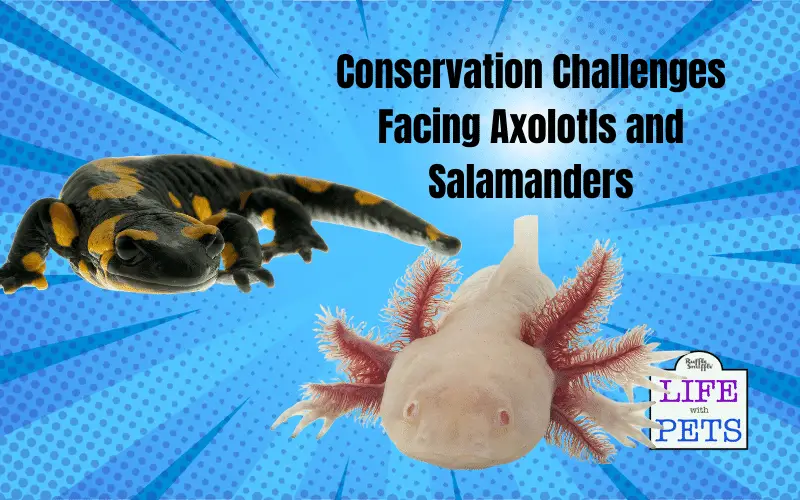Salamanders and axolotls are fascinating amphibians whose distinct characteristics spark our interest. Renowned for their capacity for regeneration, axolotls spend their entire lives submerged in water. Conversely, salamanders change through a metamorphosis that turns them from aquatic larvae to terrestrial adults.
Given the many risks these species face, conservation measures are essential for their survival. Climate change, pollution, and habitat loss threaten their survival. In addition to protecting these amazing species, protecting their habitats benefits ecosystems as a whole.
Now let’s explore the world of salamanders and axolotls and talk about how vital conservation is.
Understanding Axolotls and Salamanders
Axolotls and Salamanders exhibit fascinating diversity within the amphibian class. Taxonomically, they belong to the order Urodela, with various families and species showcasing a wide array of sizes, colors, and habitats.
It’s worth delving into a specific comparison between mudpuppies and axolotls, two intriguing species within the order Urodela. Both species share similarities as aquatic amphibians, however, they differ significantly in their life cycles and adaptations. Learn more about the subtle differences between these species in a comprehensive comparison of Mudpuppy vs Axolotl written by Josh Wayne.
Axolotls, known for exceptional regenerative abilities, retain juvenile characteristics even as adults, making them unique among amphibians. Salamanders, with their diverse adaptations, showcase the versatility of this intriguing group of animals.
Ecological Importance of Axolotls and Salamanders in the Ecosystem
Axolotls and Salamanders are essential components of their respective habitats. These amphibians play a vital role in ecosystem health. Let me tell you some of the benefits they have for their habitats:
- Salamanders and axolotls increase ecological biodiversity.
- They show the state of the environment as a whole.
- These animals aid in controlling insect populations.
- In the food webs, they play a vital role as both predators and prey.
- Salamanders support the cycling of nutrients in terrestrial environments.
- Some salamanders use their burrows to help aerate the soil.
- Unintentionally, salamanders help spread seeds.
- They demonstrate flexibility in response to shifting conditions.
- Axolotls can regenerate, which makes them useful for scientific study.
In Short, they perform a variety of beneficial tasks in nature.
Threats to Axolotls and Salamanders
Understanding the various difficulties that axolotls and salamanders face is essential to our exploration of them. These amphibians confront a variety of challenges, from habitat destruction to the threat of invasive species, highlighting the urgent need for comprehensive conservation efforts.
Habitat Destruction
Salamanders and axolotls are seriously threatened by habitat loss. The destruction of their natural habitats is a result of infrastructure development, urbanization, and agriculture, which limits their capacity to flourish in their original environments.
Pollution and Contamination
The health of these species continues to be endangered by pollution and contamination. Axolotls’ and salamanders’ health is adversely affected by the introduction of hazardous materials into their habitats via chemical runoff, industrial pollution, and improper waste disposal.
Climate Change Effects
These organisms suffer greatly from the effects of climate change, which include changes in temperature and precipitation patterns. Axolotls and Salamanders encounter a variety of difficulties as a result of shifting environmental conditions, including altered habitats, disturbed breeding cycles, and increased vulnerability to illnesses.
Invasive Species
The delicate balance of habitats where Salamanders and Axolotls live is also being challenged by the introduction of exotic species. The survival of these peculiar amphibians continues to be jeopardized by population decreases brought on by competition for resources and predation by invading species.
Case Studies [Facts and Figures]
Now let me show you some case studies on Axolotls and Salamanders to clarify my point about their race towards extinction.
Axolotls in Xochimilco Lake: A Struggle for Survival
Native to Mexico City’s Xochimilco Lake, Axolotls are seriously endangered. Several factors exacerbate their struggle to survive in this habitat.
- Habitat Loss: The rapid development of Mexico City has led to a considerable loss of their natural habitat, with large areas of the Xochimilco Lake complex being destroyed and drained.
- Water Pollution: The Xochimilco district’s contaminated canals pose a serious threat to axolotl survival.
- Invasive Species: By fighting for food and feeding on axolotls, invasive carp and tilapia upset the delicate equilibrium.
- Overfishing: An important hazard to the declining population of axolotls is the overfishing of the species.
Axolotl populations have drastically declined as a result of these sufferings. In Xochimilco, there were about 6,000 axolotls per square kilometer in 1998. This number fell to 100 by 2008, and as of right now, there are less than 35 animals per square kilometer.
Hellbenders Populations in the Appalachian Mountains: An Urgent Call to Action
The Appalachian Mountains, which span from the southern United States to Canada, are home to a wide variety of salamander species that are in danger of extinction. These factors make the need for conservation measures even more urgent:
The Appalachian native, the Hellbender, is a perfect example of the urgent need for safeguarding. The eastern Hellbender is considered a species of concern by the US government, and the Ozark subspecies has been officially designated as endangered since 2011. The goal of conservation efforts is to stop the iconic species’ dwindling populations, especially in states like Missouri and Ohio.
The Appalachian Mountains’ salamander population is at risk, which highlights the urgent need for practical conservation measures.
Existing Programs and Projects for Conservation
A wide range of ongoing initiatives and programs are already making attempts to guarantee the survival of these unusual amphibians. These undertakings, which range from creative breeding programs to extensive awareness campaigns, together weave a web of efforts meant to solve the pressing issues these animals confront. Let me brief you on three of those initiatives.
The Ajolotón initiative – Axolotl Conservation Project in Mexico City
At the vanguard of axolotl conservation is the Mexico City-based Ajolotón initiative. This seven-borough project’s goal is to promote axolotl reproduction in thoughtfully constructed habitats. These sanctuaries emphasize the value of protecting the amphibians’ natural habitats by offering a safe and clean environment for them to flourish in.
Success of the Ajolotón Initiative:
Two thousand specimens were returned to their current Xochimilco habitats, marking an important milestone. The Institute of Biology at the National Autonomous University (UNAM) has been leading axolotl conservation efforts in recent years, as mentioned by Xochimilco Mayor José Carlos Acosta. 70 ajolotarios in Xochimilco have been the site of research collaborations with UNAM, the Metropolitan Autonomous University, the University of Kent in England, and specialists from Cuba and Japan to conserve the species and promote reproduction.
Foundation for the Conservation of Salamanders (FCSal)
The Foundation for the Conservation of Salamanders (FCSal) plays a significant role in educating people about the dangers facing salamanders and their natural environments. The charity actively raises money for salamander conservation, education, and research in addition to awareness campaigns. This diverse strategy demonstrates the foundation’s commitment to tackling the many problems salamander populations face.
Success of FCSal
The organization is making great successes for the conservation of Salamanders. Some of those are listed here:
- Grant Funding: FCSal offers annual grants supporting salamander conservation, education, and research. The 2024 Daniel M. DiGiacomo Grant exemplifies this, with funding for 1 to 3 projects per year, typically ranging from $500 to $5,000. The organization has funded $66,454 in research projects since 2013.
- Mexican Salamander Conservation: Contributions to FCSal’s land purchase fund directly support the protection of Mexican salamanders, which is an important step in preserving their habitats.
- Educational Initiatives: FCSal launches “Salamander Saturday” to raise awareness of salamanders, their habitats, and ecological relevance. It also introduces educational initiatives like the “Vernal Pool coloring book” by grant recipient Kristine Hoffmann.
The accomplishments of FCSal demonstrate their commitment to salamander conservation and their ability to effectively use resources to protect these rare creatures and their habitats.
Conservation Action – What an Individual Can Do?
We have an important duty to protect axolotls and salamanders as stewards of the ecosystem. These amazing creatures, deeply tuned to both the aquatic and land environments, rely on our responsible decisions to survive. Learn how to incorporate little yet effective actions into your everyday life and contribute to the conservation of these amazing animals.
- Preserve Natural Habitat
Preserve the axolotl and salamanders’ native habitats by refraining from litter and by actively participating in neighborhood habitat restoration initiatives. Your dedication to these projects contributes to the ecosystems that are so vital to the survival of these rare amphibians being preserved and restored.
- Raise Awareness
Increase public understanding of the vital roles salamanders and axolotls play in maintaining ecological equilibrium. Assist people in realizing the importance of these unusual animals in preserving a balanced and healthy ecology.
- Support Conservation Initiatives
Contribute to local projects or groups like FCSal to support amphibian conservation. Your contributions are extremely important in supporting key conservation and research projects that save these threatened species and their habitats.
- Limit Chemical Use
Choosing environmentally friendly products can help cut down on the amount of dangerous chemicals released into the environment. Reduce the amount of fertilizer and pesticide you use in your gardens as well as practice ecologically conscious gardening to help create a more robust and sustainable ecosystem.
- Responsible Pet Ownership
You must conform to ethical and legal guidelines if you decide to keep amphibians as pets (learn more in this detailed guide to keeping axolotls). Remember, It is not appropriate to release non-native amphibians into the wild. By doing this, responsible pet ownership is promoted and local ecosystems are shielded from potential harm by non-native species.
By adopting these changes in behavior, we promote peaceful coexistence with these remarkable amphibians and become proactive guardians of salamander and axolotl conservation.
Final Thoughts
To sum up, important conservation projects like the Foundation for the Conservation of Salamanders and the Ajolotón project are propelling progress in the right direction. Employing habitat preservation, population tracking, and public education, these initiatives clear the path for a sustainable future for salamanders and axolotls.
There is still hope for salamanders and axolotls. Sustained dedication and consciousness possess the capability to counteract the decrease, guaranteeing the existence of these exceptional species for posterity.
Salamanders and axolotls need your help right now! The health of these ecosystems depends on these amphibians. Their diminishing numbers suggest that we urgently need to act as a group. To guarantee a future in which these animals flourish in their native environments, support conservation initiatives. Time is of the essence.
About Writer
I’m Josh Wayne from fitaquarium.com. I explore the exciting realm of aquatic ecosystems as a passionate aquarist and offer guidance on aquarium maintenance. My quest is driven by a deep love of the colorful and varied aquatic world.

